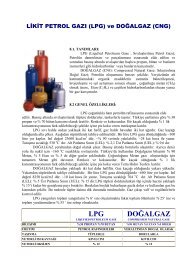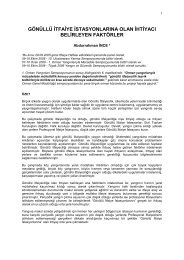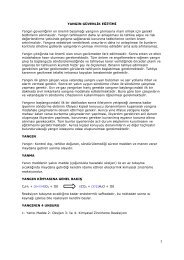buradan - Yangın
buradan - Yangın
buradan - Yangın
You also want an ePaper? Increase the reach of your titles
YUMPU automatically turns print PDFs into web optimized ePapers that Google loves.
TÜYAK BİLDİRİLER KİTABI<br />
2009 PROCEEDINGS BOOK<br />
Fire was ignited and 3 minutes pre-burn was allowed before<br />
system was discharged. From the graphs we can see a very fast<br />
temperature reduction on the vicinity of the fire and in all sections in<br />
the tunnel short after water mist discharge (Figure 11).<br />
6<br />
Temperature at +5m<br />
Temperature [°C]<br />
500<br />
400<br />
300<br />
200<br />
100<br />
0<br />
1400 1900 2400 2900<br />
TÜYAK 2009<br />
Tc[5-4-2] Tc[5-4-3] Tc[5-4-4]<br />
Tc[5-4-5] Henget Tønne<br />
Ledig<br />
Time [s]<br />
Figure 11. Diesel pool fire temperature profile at +5 m section<br />
Target wood pallet didn’t ignite and water bucket temperature<br />
increase was very small confirming system capability to prevent<br />
fire spread.<br />
Fire was completely extinguished in about 20 seconds from system<br />
discharge and visibility was clearly improved.<br />
The drop in air velocity close to the ceiling is due to back layering,<br />
which stops at activation of suppression (Figure 12).<br />
Figure 12. Diesel pool fire temperature air velocity at -40 m<br />
section<br />
50 MW Potential Wood Crib:<br />
180 pallets were placed in two lanes simulating a lorry. Total length<br />
was 4.2 m and height 2.6 m (18 pallets). (Figure 13)<br />
Figure 13. 50 MW Wood crib fire configuration (side view)<br />
Target wood pallet and water bucket were also placed at same<br />
locations as previous test.<br />
Fire was ignited and about 5 minutes pre-burn (temperature<br />
at ceiling reach rapidly to 1000 °C) was allowed before system<br />
was discharged (Figure 15). Heat release reached around 45<br />
MW before water mist system was discharged so fire was fully<br />
developed. From the graphs we can see a very fast temperature<br />
reduction on the vicinity of the fire and in all sections in the tunnel<br />
after water mist discharge.<br />
Figure 14. 50 MW Wood crib fire temperature air velocity at -40<br />
m section<br />
Figure 15. 50 MW Wood crib fire temperature profile at +5 m<br />
section<br />
Target wood pallet didn’t ignite and water bucket increase was very<br />
small.<br />
Fire was successfully suppressed and visibility was clearly<br />
improved.<br />
100 MW Potential Wood Crib:<br />
Last test was a 100 MW potential wood crib fire. Main purpose of<br />
this test was to evaluate water mist system capability to control<br />
fire that eventually could grow up to 100 MW. Water mist system<br />
was discharged before fire was fully developed. Heat released was<br />
around 50 MW at discharge time.<br />
360 pallets were placed in two lanes simulating a lorry. Total length<br />
was 8.4 m and height 2.6 m (18 pallets). (Figure 16)<br />
Target wood pallet and water bucket were also placed.<br />
Fire was ignited and about 5 minutes pre-burn (temperature at<br />
ceiling reach rapidly to 1000ºC) was allowed before system was





